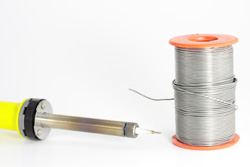Lead-free soldering for electronics and electricals
As of July 2006, EU guidelines have banned the use of lead solders, enforcing development of new joining techniques in the area of electronic and microsystem technology. First attempts of lead-free soldering have been hampered by their high temperature. Alternative highly durable, lead-free methods ensuring high thermal and mechanical stability as well as minimum heat diffusion are required. To address those issues, the EU project ‘Lead-free joining for microelectronics and microsystem technology devices’ (Joitec) developed a flexible and controllable laser welding process, the so-called laser spot welding (LSW), for use in the electronics industry. Project partners employed a laser beam with adapted wavelength to enable the welding of spots smaller than 250 nm and avoid the use of lead-based materials. Additionally, an online welding quality inspection system was developed to evaluate the correlation between welding-specific emissions and the weld quality. An important deliverable of the Joitec project was the construction of a LSW machine prototype consisting of a laser beam of 515 nm wavelength and a fibre optic beam guidance system. It also designed printed circuit boards (PCBs) in order to test and further enhance the LSW process. Joitec have taken advantage of laser technology to devise a process for lead-free welding of microelectronic devices. The developed technology is environmentally friendly and is directly applicable in the production lines of participating small and medium-sized enterprises (SMEs). Commercial exploitation of this technology would also allow SMEs to meet the European guidelines on Waste Electrical and Electronic Equipment (WEEE) and Reduction of Hazardous Substances (ROHS).







